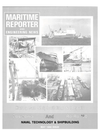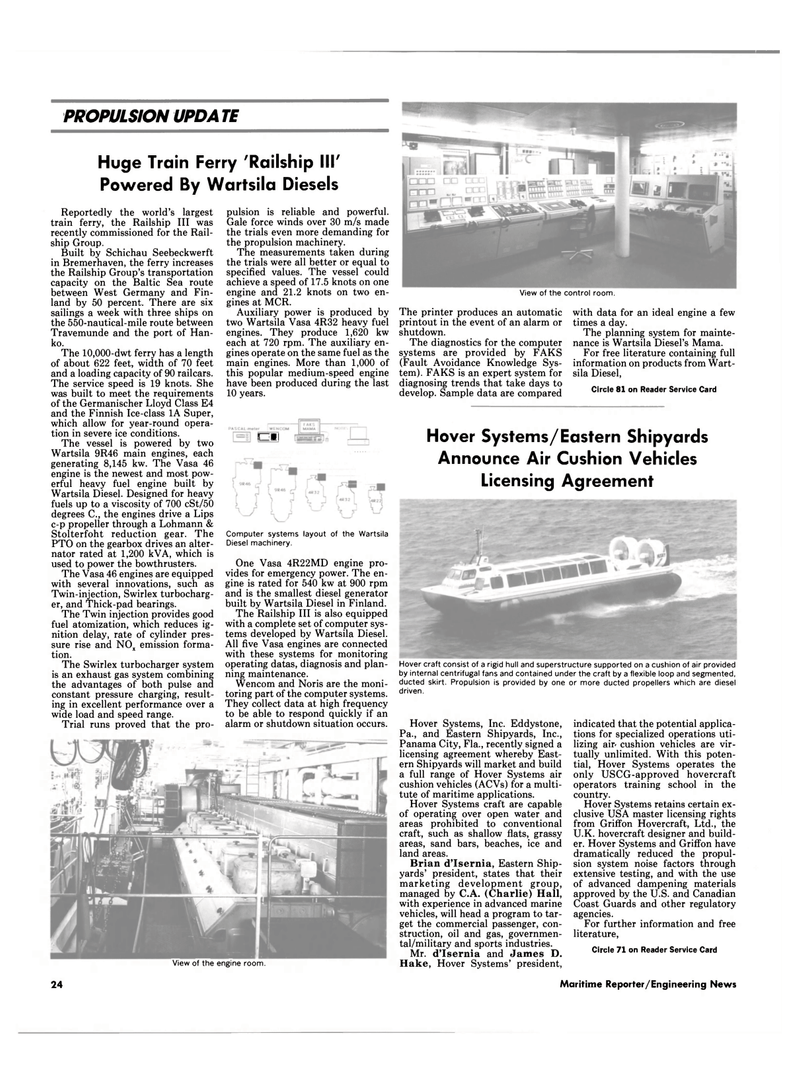
Page 22: of Maritime Reporter Magazine (May 1990)
Read this page in Pdf, Flash or Html5 edition of May 1990 Maritime Reporter Magazine
PROPULSION UPDA TE
Huge Train Ferry 'Railship III'
Powered By Wartsila Diesels
Reportedly the world's largest train ferry, the Railship III was recently commissioned for the Rail- ship Group.
Built by Schichau Seebeckwerft in Bremerhaven, the ferry increases the Railship Group's transportation capacity on the Baltic Sea route between West Germany and Fin- land by 50 percent. There are six sailings a week with three ships on the 550-nautical-mile route between
Travemunde and the port of Han- ko.
The 10,000-dwt ferry has a length of about 622 feet, width of 70 feet and a loading capacity of 90 railcars.
The service speed is 19 knots. She was built to meet the requirements of the Germanischer Lloyd Class E4 and the Finnish Ice-class 1A Super, which allow for year-round opera- tion in severe ice conditions.
The vessel is powered by two
Wartsila 9R46 main engines, each generating 8,145 kw. The Vasa 46 engine is the newest and most pow- erful heavy fuel engine built by
Wartsila Diesel. Designed for heavy fuels up to a viscosity of 700 cSt/50 degrees C., the engines drive a Lips c-p propeller through a Lohmann &
Stolterfoht reduction gear. The
PTO on the gearbox drives an alter- nator rated at 1,200 kVA, which is used to power the bowthrusters.
The Vasa 46 engines are equipped with several innovations, such as
Twin-injection, Swirlex turbocharg- er, and Thick-pad bearings.
The Twin injection provides good fuel atomization, which reduces ig- nition delay, rate of cylinder pres- sure rise and NOx emission forma- tion.
The Swirlex turbocharger system is an exhaust gas system combining the advantages of both pulse and constant pressure charging, result- ing in excellent performance over a wide load and speed range.
Trial runs proved that the pro- pulsion is reliable and powerful.
Gale force winds over 30 m/s made the trials even more demanding for the propulsion machinery.
The measurements taken during the trials were all better or equal to specified values. The vessel could achieve a speed of 17.5 knots on one engine and 21.2 knots on two en- gines at MCR.
Auxiliary power is produced by two Wartsila Vasa 4R32 heavy fuel engines. They produce 1,620 kw each at 720 rpm. The auxiliary en- gines operate on the same fuel as the main engines. More than 1,000 of this popular medium-speed engine have been produced during the last 10 years. d
View of the control room.
The printer produces an automatic printout in the event of an alarm or shutdown.
The diagnostics for the computer systems are provided by FAKS (Fault Avoidance Knowledge Sys- tem). FAKS is an expert system for diagnosing trends that take days to develop. Sample data are compared with data for an ideal engine a few times a day.
The planning system for mainte- nance is Wartsila Diesel's Mama.
For free literature containing full information on products from Wart- sila Diesel,
Circle 81 on Reader Service Card
Hover Systems/Eastern Shipyards
Announce Air Cushion Vehicles
Licensing Agreement
Computer systems layout of the Wartsila
Diesel machinery.
One Vasa 4R22MD engine pro- vides for emergency power. The en- gine is rated for 540 kw at 900 rpm and is the smallest diesel generator built by Wartsila Diesel in Finland.
The Railship III is also equipped with a complete set of computer sys- tems developed by Wartsila Diesel.
All five Vasa engines are connected with these systems for monitoring operating datas, diagnosis and plan- ning maintenance.
Wencom and Noris are the moni- toring part of the computer systems.
They collect data at high frequency to be able to respond quickly if an alarm or shutdown situation occurs.
Hover craft consist of a rigid hull and superstructure supported on a cushion of air provided by internal centrifugal fans and contained under the craft by a flexible loop and segmented, ducted skirt. Propulsion is provided by one or more ducted propellers which are diesel driven.
View of the engine room.
Hover Systems, Inc. Eddystone,
Pa., and Eastern Shipyards, Inc.,
Panama City, Fla., recently signed a licensing agreement whereby East- ern Shipyards will market and build a full range of Hover Systems air cushion vehicles (ACVs) for a multi- tute of maritime applications.
Hover Systems craft are capable of operating over open water and areas prohibited to conventional craft, such as shallow flats, grassy areas, sand bars, beaches, ice and land areas.
Brian d'lsernia, Eastern Ship- yards' president, states that their marketing development group, managed by C.A. (Charlie) Hall, with experience in advanced marine vehicles, will head a program to tar- get the commercial passenger, con- struction, oil and gas, governmen- tal/military and sports industries.
Mr. d'lsernia and James D.
Hake, Hover Systems' president, indicated that the potential applica- tions for specialized operations uti- lizing air- cushion vehicles are vir- tually unlimited. With this poten- tial, Hover Systems operates the only USCG-approved hovercraft operators training school in the country.
Hover Systems retains certain ex- clusive USA master licensing rights from Griffon Hovercraft, Ltd., the
U.K. hovercraft designer and build- er. Hover Systems and Griffon have dramatically reduced the propul- sion system noise factors through extensive testing, and with the use of advanced dampening materials approved by the U.S. and Canadian
Coast Guards and other regulatory agencies.
For further information and free literature,
Circle 71 on Reader Service Card 24 Maritime Reporter/Engineering News

 21
21

 23
23
